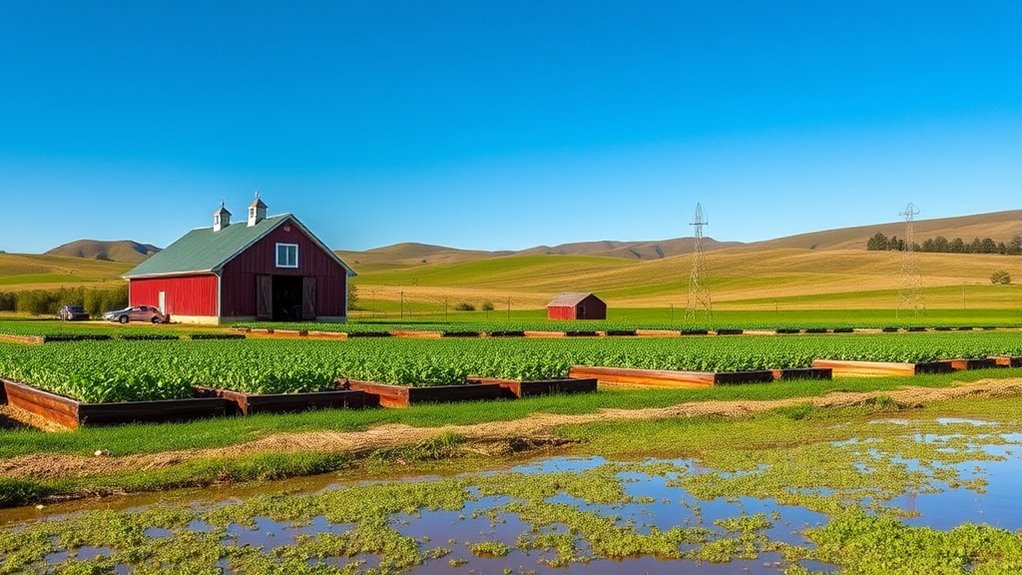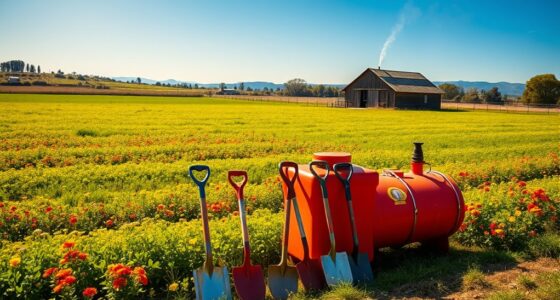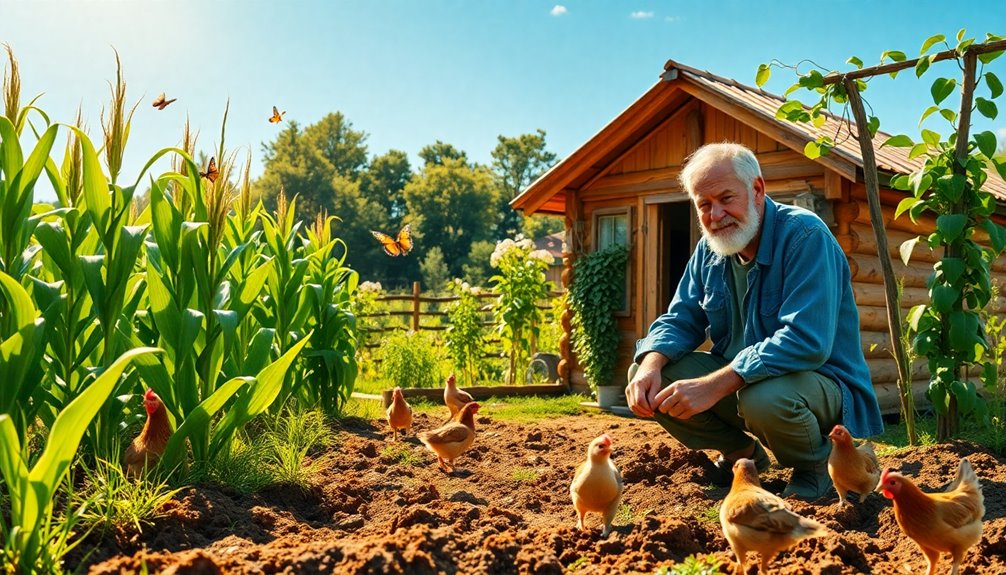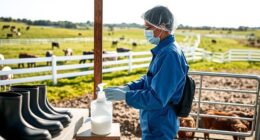To flood-proof your farm, start by understanding your flood zone and its impact on your crops. Choose flood-resistant varieties and improve soil drainage with raised beds and efficient irrigation practices. Protect your livestock by providing portable shelters and preparing an emergency plan. After floods, assess damages quickly and use cover crops to restore soil health. Implement ongoing flood management strategies to enhance resilience. There's more to discover on practical steps for safeguarding your agricultural investments.
Key Takeaways
- Conduct soil tests to assess fertility and select flood-resistant crop varieties for vulnerable areas.
- Implement efficient water management practices, such as drip irrigation and raised beds, to enhance drainage.
- Use interlocking crates and water gates for flexible and rapid flood management solutions.
- Establish a comprehensive emergency preparedness plan, including evacuation routes and essential contact information.
- Regularly assess and improve soil health with organic amendments and cover crops to reduce erosion.
Understanding Flood Zones and Their Impact on Agriculture
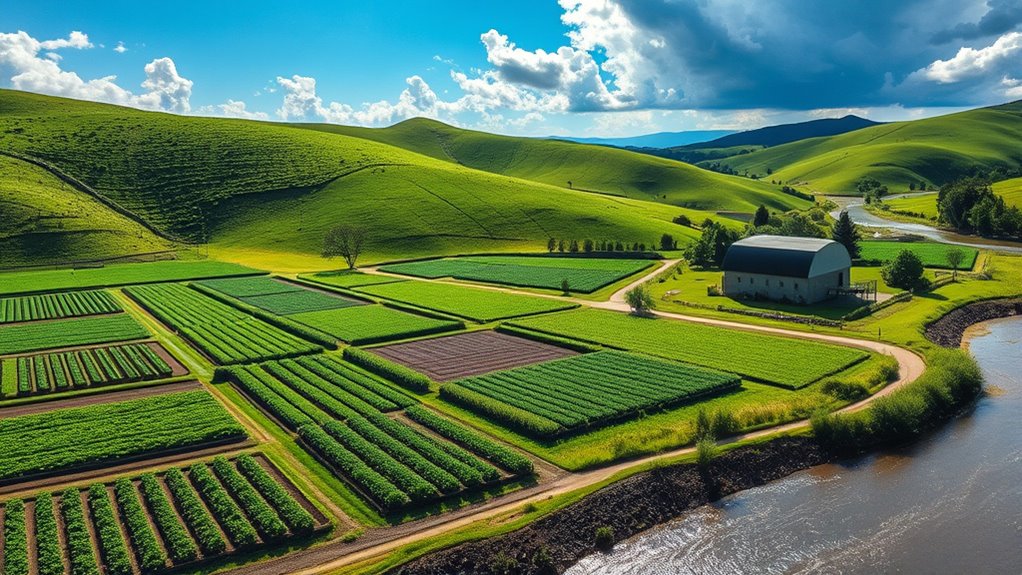
Flood zones play a critical role in shaping agricultural practices and decisions. When you're farming in areas classified as Zone A, you face high flood risks that can severely impact your soil structure and crop yields.
Regular flooding can drown crops, damage root systems, and create waterlogged conditions, making your plants more susceptible to diseases. Plus, erosion from floods can wash away nutrient-rich topsoil, essential for healthy growth, leading to significant economic losses.
Best Practices Before Planting and Irrigation Management

Before you plant, it's essential to conduct soil tests to understand your land's fertility and nutrient levels.
Choosing flood-resistant crop varieties can help protect your yields in vulnerable areas.
Efficient water management practices, like drip irrigation, won't only conserve resources but also support healthier crops during challenging weather conditions.
Soil Testing Importance
Soil testing is an essential step in preparing your farm for successful planting and effective irrigation management. By evaluating your soil's fertility levels and nutrient composition, you can make informed amendments that support crop growth.
Soil tests reveal critical data on pH, organic matter content, and texture, helping you choose the right crops and manage irrigation efficiently. Regular evaluations also identify drainage issues and compacted areas, allowing you to improve water infiltration and reduce flood damage risks.
With accurate soil test results, you can optimize your irrigation schedules, preventing overwatering that may lead to root diseases. Maintaining the ideal soil composition guarantees resilience against flooding, contributing to your farm's overall health.
Flood-Resistant Crop Selection
When selecting crops for areas prone to flooding, it's crucial to take into account varieties that can withstand excess water. Flood-resistant crop selection, like certain types of rice and sorghum, can greatly reduce yield losses during flooding events. These crops are better suited to endure prolonged water exposure.
Additionally, consider implementing raised beds or elevated planting areas to enhance drainage and prevent crop drowning. Conducting soil tests before planting helps identify the best crops for your soil's fertility and flood risks.
Finally, utilizing cover crops prior to the main planting season improves soil structure, enhancing its capacity to manage excess water and reducing erosion risks during floods. These practices can considerably boost your farm's resilience.
Efficient Water Management
Effective water management is essential for maximizing crop yields and minimizing losses, especially in flood-prone areas.
Start by conducting soil tests to understand your soil's fertility and nutrient composition. This optimization helps you plan for effective irrigation management.
Implement proper drainage systems, like subsurface tile drainage, to manage water levels and prevent waterlogging during heavy rains. Creating raised beds can further improve drainage and reduce root diseases.
For irrigation, consider using drip methods to apply water precisely, conserving resources and minimizing runoff.
Regularly monitor soil moisture levels with sensors or manual techniques to fine-tune your irrigation schedule and avoid overwatering, which can harm your crops.
With these practices, you can guarantee efficient water management on your farm.
Protecting Livestock in Flood-Prone Areas

Flooding can pose a serious threat to livestock, making it crucial for farmers to take proactive steps to protect their animals. Start by implementing elevated or portable shelters to keep your livestock safe from rising floodwaters. Stockpile emergency feed and medications so you're prepared when access to supplies is limited. Develop a clear evacuation plan with designated routes and safe zones for timely relocation. Monitor weather forecasts and use alert systems to stay informed about flood warnings. Finally, mark your animals with identification tags to prevent loss during evacuations.
| Action | Purpose |
|---|---|
| Elevated shelters | Protect livestock from floodwaters |
| Emergency feed stockpile | Guarantee livestock have food during flooding |
| Evacuation plan | Facilitate timely relocation |
| Identification tags | Prevent loss during floods |
Developing an Emergency Plan

When developing your emergency plan, it's vital to establish clear evacuation routes and guarantee everyone knows them.
You should also compile a list of emergency contact information for local authorities and services, making it easy to reach out when needed.
Emergency Contact Information
Creating an emergency plan is vital for safeguarding your farm during a flood. Start by compiling a thorough list of emergency contact numbers, including local authorities, agricultural extension services, and nearby farms for resource sharing.
Make sure that all family members and employees know this list and how to use it during an evacuation or disaster. Regularly update the contact information to reflect changes in resources or services.
Don't forget to include veterinarians and animal rescue organizations to protect your livestock and pets. Designate a specific person responsible for communicating with these contacts during a flood event.
This streamlines information dissemination and coordination efforts, making your preventive measures more effective in an emergency.
Evacuation Route Planning
To guarantee everyone's safety during an emergency, having a well-planned evacuation route is essential.
You need to verify your evacuation route planning is thorough and accessible during extreme weather. Here are key steps to contemplate:
- Map the Site: Create a detailed farm map showing buildings, access routes, and hazardous areas.
- Multiple Routes: Include several evacuation options to adapt to changing flood conditions and road closures.
- Regular Drills: Conduct practice drills with family and employees to verify everyone knows the plan and reduce panic.
- Emergency Contacts: Maintain an updated list of local emergency contacts and resources for assistance during and after flooding incidents.
Don't forget to review your flood insurance policy, verifying it aligns with your evacuation strategy.
Post-Flood Practices
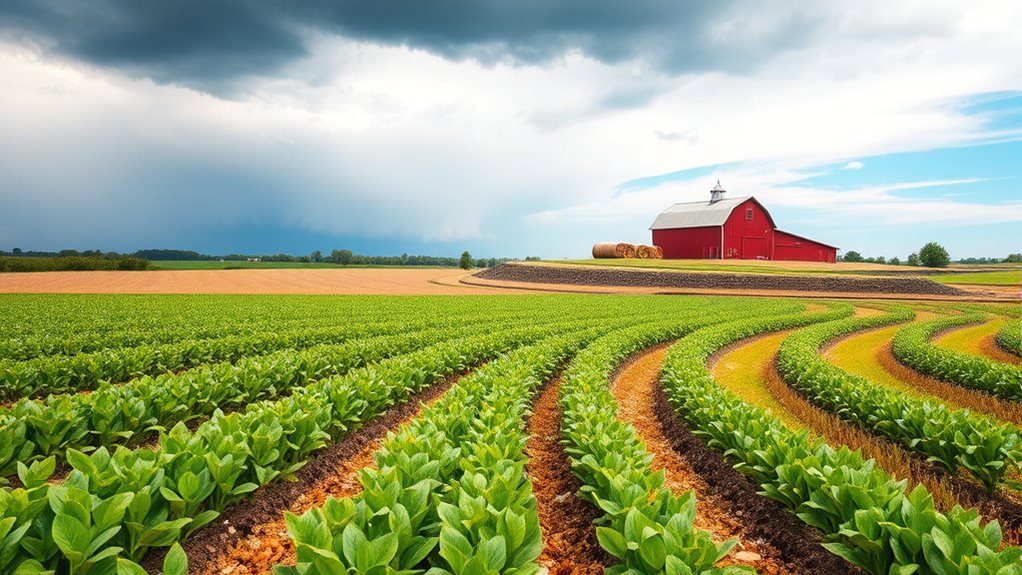
After a flood, it's crucial to quickly assess the damage to your farm, as this will guide your recovery efforts.
Start by inspecting your fields and documenting the impact on your crops and infrastructure. Remove debris and sediment left by floodwaters to clear the way for recovery.
Incorporate organic matter and soil amendments to restore soil health effectively. Plant cover crops immediately to prevent soil erosion and enhance nutrient content. These crops will also improve soil structure, promoting resilience for future growing seasons.
Don't forget to regularly assess and rehabilitate your irrigation systems to make certain they're functioning efficiently.
Taking these steps will help you bounce back and prepare for future challenges on your farm.
Implementing Flood Prevention Measures for the Future

While floods can be devastating, implementing effective prevention measures now can greatly reduce your farm's vulnerability in the future.
Here are some steps you can take:
- Install Subsurface Tile Drainage: This technique manages the water table effectively and can enhance your farm's profitability.
- Utilize Modular Flood Prevention Systems: These interlocking crates offer flexible, portable solutions tailored to your needs.
- Install Water Gates: A lightweight, aboveground method that allows for rapid deployment during emergencies.
- Incorporate Cover Crops: These improve soil health and structure, enhancing water infiltration and reducing vulnerability in flood-prone areas.
Frequently Asked Questions
How to Protect Farms From Flooding?
To protect your farm from flooding, start by implementing subsurface tile drainage systems, as they effectively manage the water table.
You can also deploy water-inflated property protectors for quick, durable barriers against floodwaters.
Consider setting up a modular flood prevention system with interlocking crates to adapt to various flood risks.
Regularly assess soil conditions and keep essential documents and equipment elevated in waterproof containers to minimize damage during emergencies.
Stay proactive!
What Are the 5 Ways of Preventing Flooding?
Imagine your farm as a fortress, standing strong against nature's onslaught. To prevent flooding, you can implement effective drainage systems to manage water levels.
Install flood-resistant irrigation and drip systems to minimize waterlogging, and use flood barrier socks to shield fragile crops. Consider modular flood prevention systems for customizable protection, and regularly assess your soil to guarantee drainage effectiveness.
Each step fortifies your fortress, safeguarding your crops against the relentless tide.
What Are the Steps for Flood Preparedness?
To prepare for a flood, start by installing a sump pump in your basement, complete with a battery backup.
Keep your gutters clean and direct downspouts away from your foundation.
Develop an emergency plan for your family and employees, including evacuation routes and communication methods.
Regularly review your insurance coverage, ensuring you have flood insurance.
Finally, prepare an evacuation kit with essentials like medications, clothing, and chargers for a quick getaway if needed.
What Are Five Main Points You Should Do to Prepare for Flooding?
To prepare for flooding, start by evaluating your property to pinpoint flood-prone areas.
Create an emergency plan that includes evacuation routes and communication strategies.
Install a sump pump with a battery backup to prevent water buildup during outages.
Store important documents safely and keep digital copies, following the 3-2-1 backup rule.
Finally, equip your space with modular flood prevention systems that are easy to assemble and store when not needed.
Conclusion
By taking these proactive steps, you're not just weatherproofing your farm; you're building an ark in the face of rising tides. Your crops and livestock are the lifeblood of your land, and with careful planning, you can safeguard them against nature's whims. Embrace the challenge, and let your resilience blossom like wildflowers after a storm. Remember, it's not just about surviving floods; it's about thriving in the aftermath and nurturing your farm for generations to come.

